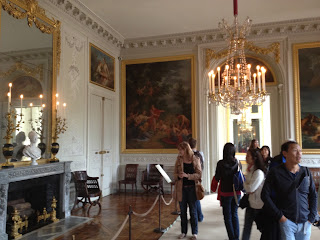
I have been to the Palace of Versailles twice prior to this stay in France, and it has absolutely met my expectations as a national monument, fabulously preserved and restored to its former splendor as proof of France’s royal past. Both times, the crowds seemed normal, the occasional construction and renovation efforts understandable. I always had time and space to contemplate and imagine the thousands of souls who once lived there and reigned over the grandest kingdom in Europe. A lot can happen in eight years…
Sadly, Versailles has somewhat lost the magisterial air it once held for me. Much has been beautifully restored in recent years, but with that restoration have come additions, most of which cheapened the historical experience during my visit last Tuesday.


In contrast to the glorious re-gilding of the palace roofline, and the painstaking reconstruction of the original gate separating the Cour d’honneur from the Cour royale, a large security checkpoint has been erected in the middle of the forecourt. Security is an obvious necessity in such an environment, but the checkpoint is a monstrosity of wood planks and glass, marring the order of the space, reminding all who enter that, yes, you are entering one of the largest tourist draws on the planet.
A number of new, wildly overpriced chain cafés and
restaurants have appeared in the main palace and upon the grounds. The gift
shops have multiplied. Perhaps it’s possible I never noticed some of them
before, but there appear now to be so many that they honestly get in the way of
simply navigating the museum. Add this to the indescribably large hordes of
visitors (every school group in Europe was touring the château that day), titanic
cameras flailing above a horizon of heads, and it’s virtually impossible to
really see the place.
The carriage rides throughout the royal gardens have always
existed, but instead of the somewhat more elegant bicycles for rent in the past
(I didn’t see them this time), massive, vulgar people-movers shuttle between
the palace and the Grand Trianon. (Of course, this costs 3,70€.) Large, yellow
floating dividers have been placed along the Grand Canal, marking boundaries
for rentable canoes. Sigh.





That aside, I marveled at le domaine de Marie Antoinette in its entirety that day. Passing
beyond the pomp and formality of Louis XIV’s fountains and parterres, I entered
the mazelike park that composes the rest of the château’s grounds. Fashioned to
look like a natural, untamed Eden – according to the aristocratic tastes of the
18th century – it really takes seeing this space in person to
comprehend how the French court existed in its own realm, geographically and
psychologically detached from its own people, in a fantasy land of privilege.
The Petit Trianon is a wonder of neo-classical restraint and elegance, and it would hard to describe it as anything other than an escape. The faux “hamlet” is every bit the stage-like assemblage of quaint cottages it was intended to be. The mix of artifice and function lend a dream-like quality to everything.
In this space, Versailles’ spirits still linger, and I left
Marie Antoinette’s “estate” on a solemn note. Her mark was still present in
every room, the personality and tastes of a former queen who loved her intimate
company, and the comforts her station afforded her.
One can’t help but leave judgments about Marie Antoinette, so reviled by history, at the door to this intimate paradise.
One can’t help but leave judgments about Marie Antoinette, so reviled by history, at the door to this intimate paradise.



No comments:
Post a Comment